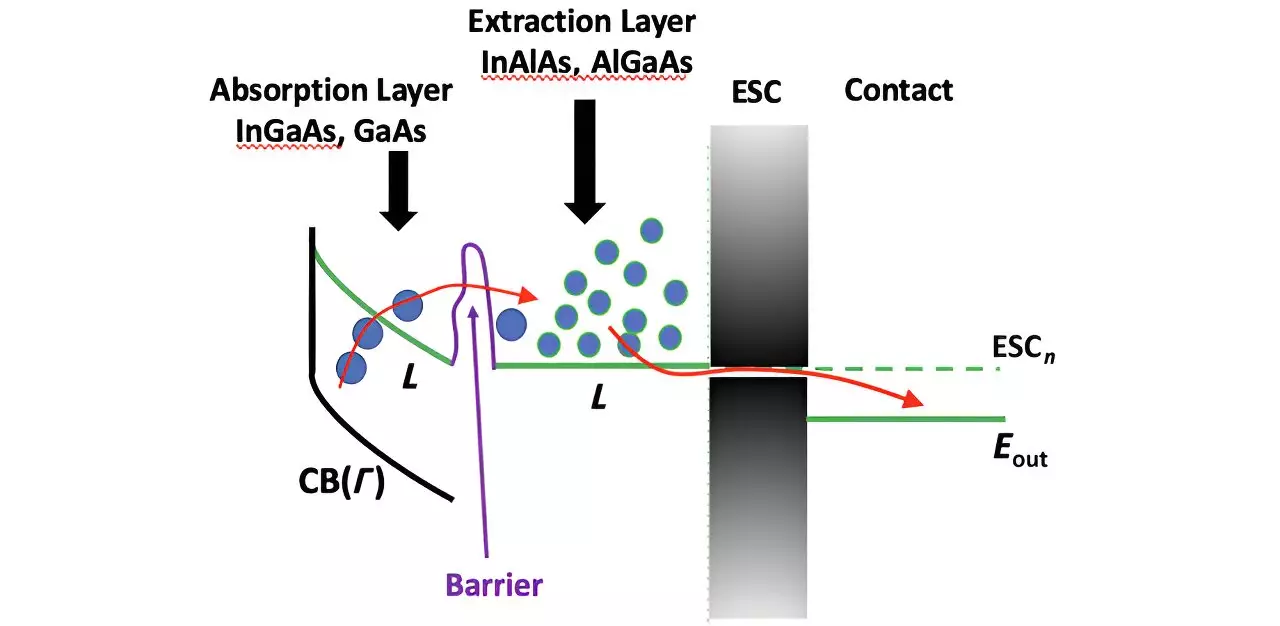The quest for renewable energy sources has intensified in recent decades, with solar power being one of the most promising technologies. Among the various innovations in solar energy, hot carrier solar cells have emerged as a potential game-changer. Conceived over thirty years ago, these cells aim to overcome the inherent limitations posed by the Shockley-Queisser efficiency limit, a theoretical benchmark for single-junction solar cells. The vision behind hot carrier technology is not just to enhance efficiency but also to revolutionize how we harness solar energy.
At the heart of hot carrier solar cells lies the concept of utilizing ‘hot’ electrons—those with excess kinetic energy gained from absorbing sunlight. The challenge, however, comes in extracting these hot electrons effectively across material boundaries, a process fundamental to the energy conversion mechanism. Traditional implementations fall short due to intricacies at the interfaces, where rapid electron extraction is often impeded by a parasitic barrier. This barrier arises when the energy bands of different materials are misaligned, leading to inefficient movement of electrons.
Recent studies have indicated that while the conduction band features unique satellite valleys capable of storing hot electrons momentarily, the practical extraction process is fraught with challenges. This phenomenon occurs in real space, wherein electrons often struggle against barriers that are seldom uniform at the nanoscale interfaces. Consequently, understanding how to optimize these energy bands and address the complexities of electron tunneling is crucial for the future viability of hot carrier devices.
To tackle these issues, researchers have begun to adopt advanced methodologies to analyze the behavior of electrons at the heterostructure junctions. One promising approach is the empirical pseudopotential method, which allows for effective calculations of the energy bands in momentum space and their correlation with experimental findings. A recent paper published in the Journal of Photonics for Energy delves into this area by exploring the effects of evanescent states on electron tunneling.
The insights derived from these investigations are pivotal, as they reveal how varying material compositions affect tunneling coefficients—the metric that quantifies how readily electrons traverse these barriers. Notably, when examining systems like indium-aluminum-arsenide (InAlAs) and indium-gallium-arsenide (InGaAs), researchers discovered that even minimal roughness at the interfaces could have detrimental effects on electron mobility. Such findings explain the subpar performance observed in many experimental configurations utilizing these materials.
Amidst the complexities of hot carrier extraction, notable progress has been observed in the use of aluminum-gallium-arsenide (AlGaAs) and gallium-arsenide (GaAs) structures. The adaptability of aluminum content in AlGaAs allows for improved alignment of energy bands, creating a more conducive environment for the movement of hot electrons. This alignment facilitates a profound enhancement in the tunneling coefficient, which can reach values as high as 0.88, depending on specific compositions utilized.
Such advancements indicate a pivotal direction for developing hot carrier solar cells that can operate well beyond the single bandgap limit. The compelling prospects of these materials signal an advancement not just in the technology itself but also in our approach to solar energy harvesting, suggesting a pathway for more efficient conversion methods.
An intriguing characteristic of AlGaAs/GaAs systems is their ability for real-space transfer of hot carriers. In a typical high-electron mobility transistor configuration, one might prefer limited backward flow of carriers; however, for valley photovoltaics, the efficient movement of hot carriers back into AlGaAs represents a beneficial feature. This mechanism allows for better capture and storage of energy, which is the essence of a functional valley photovoltaic system.
With the growing body of research revealing intricate details about these processes, there’s an unmistakable sense of optimism about the future of hot carrier solar cells. The convergence of cutting-edge material science, advanced modeling techniques, and a deeper understanding of electron dynamics could well lead to the realization of solar technologies that not only meet but exceed current efficiency standards.
While the implementation of hot carrier solar cells faces formidable challenges, ongoing research holds significant promise. By addressing issues of electron transfer across material interfaces, particularly through innovative material choices such as AlGaAs and GaAs, the solar energy landscape could experience a much-needed transformation. The journey toward breaking efficiency limitations is complex, yet the potential rewards could be monumental—ushering in a new era for clean and sustainable solar power. As we look ahead, the synergy between theoretical insights and experimental breakthroughs will undoubtedly define the next chapter in solar energy technology.


Leave a Reply